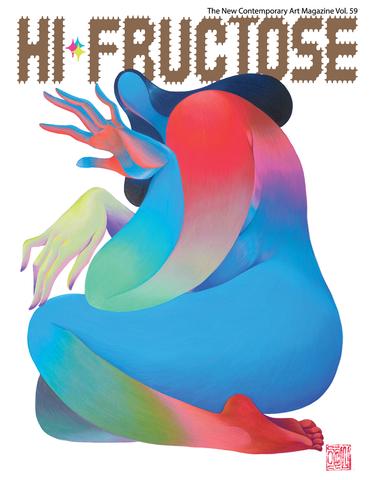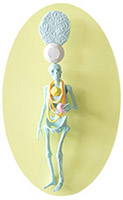
The Enigmatic – Figure Frode Bolhuis in Hi Fructose magezine by Michelle Robertson
Bolhuis finds himself guided largely by his own intuition. Polymer clay is a forgiving medium — it bakes up in under a half hour in a home oven — and it fosters Bolhuis’ sense of playfulness and exploration.
“I just try things,” he said. “And it’s very much about intuition, which is my main love.”
With polymer, he says he “never knows what’s going to happen.”
Bolhuis begins with a small armature of metal before he layers on clay and watches as “the figure happens between my hands.”
He never uses a model. Rather, the “face just happens, the clothes just happen, the posture just happens.”
It’s all about finding the right composition. Bolhuis continuously asks himself as he’s making a sculpture: “Does it feel good?”
Bolhuis works somewhat like a novelist. He has a vague idea in mind of what the work will be, but as he’s crafting it, the character seems to take on a life of its own, as if by magic.
His sculptures, he says, “want to live their own lives.”
________________________________________
Bolhuis’ own life is unconventional by most standards. A few years ago, he found himself living in an expensive house outside Amsterdam with an expensive studio nearby. It didn’t feel right. So he got together with some friends and returned to where it all started: the quaint city of Almere in the polder of Southern Flevoland.
Here, where Bolhuis grew up, he and some like-minded compatriots built a row of nine houses — each nearly identical on the outside, but completely unique within — with studios attached.
Building community has had its challenges. Babies were born, people died or moved on, but the community persists.
“The dream holds its limits,” Bolhuis said. “It takes a lot of time to be a community and to learn that. I think it was normal 100 years ago, but now we are used to looking only after ourselves and our own families.”
“It isn’t always joy, but it’s always interesting.”
________________________________________
In addition to his own practice, Bolhuis teaches one day a week at the renowned Design Academy Eindhoven.
The most important lesson he teaches is “that when you just start, it happens.”
That just might be Bolhuis’ resounding life philosophy.
“We give the students quite difficult tasks, and it’s always amazing what they do,” he said. “If they try to understand what they’re doing, though, they can’t get anywhere. They have to understand that it might take years, but it’ll happen.”
It’s this quality of the magical that seems to unify Bolhuis’s life.
He tries not to think about his practice too much. Rather than having the answers, Bolhuis resides in the space of the unknown — a realm where the possibilities stretch on endlessly but are always, somehow, within reach.
He’s not sure what his work means — “maybe it’s something to do with being human” — but what he is certain of is the process.
“I just love seeing what happens,” he said.Ondanks dat de nadere kennismaking met design Frode heeft geïnspireerd en hij bijvoorbeeld fan is van de veelzijdige ontwerper Jaime Hayon, zijn de beperkingen van het vak te groot, wat hem betreft. “Design heeft weliswaar met mensen te maken, maar gaat over heel concrete dingen, terwijl kunst alles open laat. Dat grenzenloze is zo mooi…. Ik vertel met mijn werk graag over een mens in ontwikkeling, iemand die zoekt of net vind. Toch boeit het hem om de grensgebieden tussen kunst en design te verkennen en telkens nieuwe wegen te zoeken, nieuwe skills te leren. Een groot voorbeeld ziet hij in de Japans-Amerikaanse kunstenaar en designer Isamu Noguchi: “Hij is altijd al mijn favoriete kunstenaar geweest. Die man kon alles, werkte op een breed terrein en heeft de meest uiteenlopende disciplines onderzocht. Van sculptuur tot design en tuinarchitectuur. Hij zag de beeldende kunst niet als een geïsoleerd veld maar als een wijde wereld. Fantastisch!”

